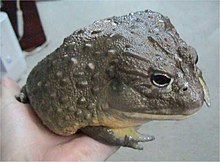| Pyxicephalus | |
|---|---|

| |
| African bull frog Pyxicephalus adspersus | |
| Scientific classification | |
| Domain: | Eukaryota |
| Kingdom: | Animalia |
| Phylum: | Chordata |
| Class: | Amphibia |
| Order: | Anura |
| Family: | Pyxicephalidae |
| Subfamily: | Pyxicephalinae |
| Genus: | Pyxicephalus Tschudi, 1838 |
| Synonyms | |
|
Maltzania Boettger, 1881 | |
Pyxicephalus (πυξίς, pyxis = "(round) box," κεφαλή, kephalē = "head") is a genus of true frogs from Sub-Saharan Africa, commonly referred to as African bull frogs or bull frogs. They are very large (P. adspersus) to large (remaining species) frogs, with females significantly smaller than males. They may take decades to reach their full size potential and they are some of the longest-living frogs, possibly able to reach ages as high as 45 years.
These bulky and voracious predators will eat any animal (including small vertebrates and conspecifics) they can fit in their large mouth that has two fang-like projections on the lower jaw, but they are themselves commonly eaten by humans, predatory birds, mammals and monitor lizards. They remain hidden—they are fossorial—for much of the year, but emerge to breed in temporary pools after rains. The tadpoles often are guarded by the male.
Species
There are five recognized species:
- Pyxicephalus adspersus Tschudi, 1838 – African bullfrog
- Pyxicephalus angusticeps Parry, 1982
- Pyxicephalus beytelli du Preez, 2024
- Pyxicephalus edulis Peters, 1854 – edible bullfrog
- Pyxicephalus obbianus Calabresi, 1927 – Calabresi's bullfrog
P. edulis has long been confused with P. adspersus, and species limits between them are not fully understood. Additionally, P. angusticeps was only revalidated in 2013, and some authorities still do not recognize it. Another sometimes used name in the genus is P. cordofanus Steindachner, 1867, but it is a nomen dubium; the International Union for Conservation of Nature lists it as "data deficient", citing "continuing doubts as to its taxonomic validity, extent of occurrence, status and ecological requirements".
References
- ^ Frost, Darrel R. (2017). "Pyxicephalus Tschudi, 1838". Amphibian Species of the World: an Online Reference. Version 6.0. American Museum of Natural History. Retrieved 26 March 2017.
- ^ Scott, E.; J.D. Visser; C.A. Yetman; L. Oliver; D.G. Broadley (2013). "Revalidation of Pyxicephalus angusticeps Parry, 1982 (Anura: Natatanura: Pyxicephalidae), a bullfrog endemic to the lowlands of eastern Africa". Zootaxa. 3599 (3): 201–228. doi:10.11646/zootaxa.3599.3.1. hdl:2263/57608. PMID 24613871.
- ^ Channing, A.; K.M. Howell (2006). Amphibians of East Africa. Cornell University Press. pp. 318–324. ISBN 9783930612536.
- "Pyxicephalidae". AmphibiaWeb. University of California, Berkeley. 2017. Retrieved 26 March 2017.
- "Pyxicephalus beytelli". Retrieved 8 May 2024.
- "Pyxicephalus Tschudi, 1838". African Amphibians. Retrieved 26 March 2017.
- Frost, Darrel R. (2017). "Anura". Amphibian Species of the World: an Online Reference. Version 6.0. American Museum of Natural History. Retrieved 26 March 2017.
- Sherif Baha El Din (2004). "Pyxicephalus cordofanus". IUCN Red List of Threatened Species. 2004: e.T58579A11788047. doi:10.2305/IUCN.UK.2004.RLTS.T58579A11788047.en. Retrieved 17 November 2021.
| Taxon identifiers | |
|---|---|
| Pyxicephalus | |